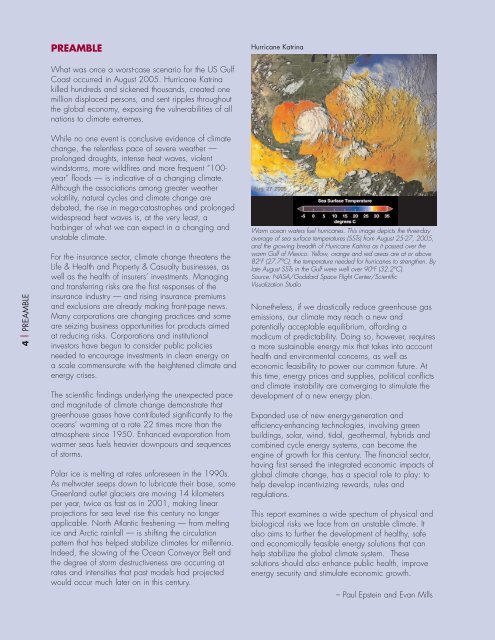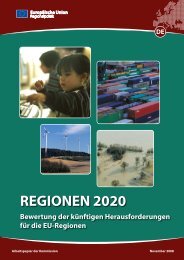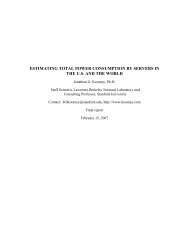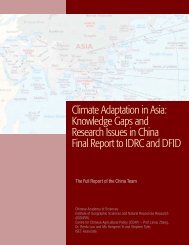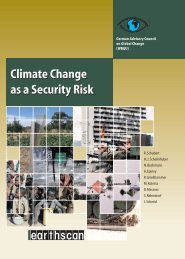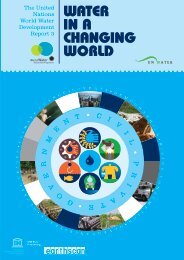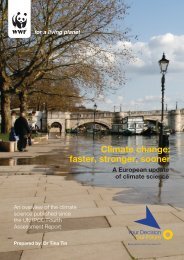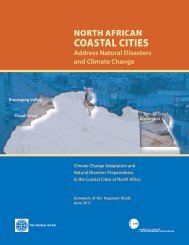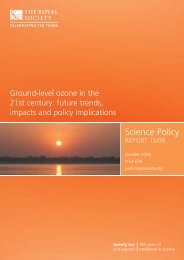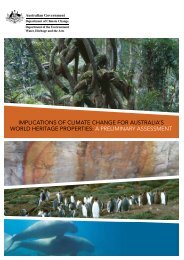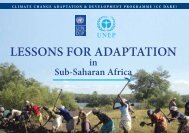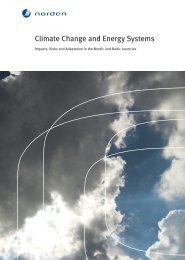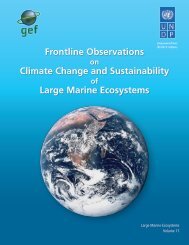Climate change futures: health, ecological and economic dimensions
Climate change futures: health, ecological and economic dimensions
Climate change futures: health, ecological and economic dimensions
You also want an ePaper? Increase the reach of your titles
YUMPU automatically turns print PDFs into web optimized ePapers that Google loves.
PREAMBLEHurricane Katrina4 | PREAMBLEWhat was once a worst-case scenario for the US GulfCoast occurred in August 2005. Hurricane Katrinakilled hundreds <strong>and</strong> sickened thous<strong>and</strong>s, created onemillion displaced persons, <strong>and</strong> sent ripples throughoutthe global economy, exposing the vulnerabilities of allnations to climate extremes.While no one event is conclusive evidence of climate<strong>change</strong>, the relentless pace of severe weather —prolonged droughts, intense heat waves, violentwindstorms, more wildfires <strong>and</strong> more frequent “100-year” floods — is indicative of a changing climate.Although the associations among greater weathervolatility, natural cycles <strong>and</strong> climate <strong>change</strong> aredebated, the rise in mega-catastrophes <strong>and</strong> prolongedwidespread heat waves is, at the very least, aharbinger of what we can expect in a changing <strong>and</strong>unstable climate.For the insurance sector, climate <strong>change</strong> threatens theLife & Health <strong>and</strong> Property & Casualty businesses, aswell as the <strong>health</strong> of insurers’ investments. Managing<strong>and</strong> transferring risks are the first responses of theinsurance industry — <strong>and</strong> rising insurance premiums<strong>and</strong> exclusions are already making front-page news.Many corporations are changing practices <strong>and</strong> someare seizing business opportunities for products aimedat reducing risks. Corporations <strong>and</strong> institutionalinvestors have begun to consider public policiesneeded to encourage investments in clean energy ona scale commensurate with the heightened climate <strong>and</strong>energy crises.The scientific findings underlying the unexpected pace<strong>and</strong> magnitude of climate <strong>change</strong> demonstrate thatgreenhouse gases have contributed significantly to theoceans’ warming at a rate 22 times more than theatmosphere since 1950. Enhanced evaporation fromwarmer seas fuels heavier downpours <strong>and</strong> sequencesof storms.Polar ice is melting at rates unforeseen in the 1990s.As meltwater seeps down to lubricate their base, someGreenl<strong>and</strong> outlet glaciers are moving 14 kilometersper year, twice as fast as in 2001, making linearprojections for sea level rise this century no longerapplicable. North Atlantic freshening — from meltingice <strong>and</strong> Arctic rainfall — is shifting the circulationpattern that has helped stabilize climates for millennia.Indeed, the slowing of the Ocean Conveyor Belt <strong>and</strong>the degree of storm destructiveness are occurring atrates <strong>and</strong> intensities that past models had projectedwould occur much later on in this century.Warm ocean waters fuel hurricanes. This image depicts the three-dayaverage of sea surface temperatures (SSTs) from August 25-27, 2005,<strong>and</strong> the growing breadth of Hurricane Katrina as it passed over thewarm Gulf of Mexico. Yellow, orange <strong>and</strong> red areas are at or above82 0 F (27.7°C), the temperature needed for hurricanes to strengthen. Bylate August SSTs in the Gulf were well over 90 0 F (32.2°C).Source: NASA/Goddard Space Flight Center/ScientificVisualization StudioNonetheless, if we drastically reduce greenhouse gasemissions, our climate may reach a new <strong>and</strong>potentially acceptable equilibrium, affording amodicum of predictability. Doing so, however, requiresa more sustainable energy mix that takes into account<strong>health</strong> <strong>and</strong> environmental concerns, as well as<strong>economic</strong> feasibility to power our common future. Atthis time, energy prices <strong>and</strong> supplies, political conflicts<strong>and</strong> climate instability are converging to stimulate thedevelopment of a new energy plan.Exp<strong>and</strong>ed use of new energy-generation <strong>and</strong>efficiency-enhancing technologies, involving greenbuildings, solar, wind, tidal, geothermal, hybrids <strong>and</strong>combined cycle energy systems, can become theengine of growth for this century. The financial sector,having first sensed the integrated <strong>economic</strong> impacts ofglobal climate <strong>change</strong>, has a special role to play: tohelp develop incentivizing rewards, rules <strong>and</strong>regulations.This report examines a wide spectrum of physical <strong>and</strong>biological risks we face from an unstable climate. Italso aims to further the development of <strong>health</strong>y, safe<strong>and</strong> <strong>economic</strong>ally feasible energy solutions that canhelp stabilize the global climate system. Thesesolutions should also enhance public <strong>health</strong>, improveenergy security <strong>and</strong> stimulate <strong>economic</strong> growth.– Paul Epstein <strong>and</strong> Evan Mills


